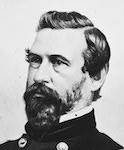 Open main menu
Open main menu
 Open main menu
Open main menu

W.T.H. Brooks
(1821 - 1870)
Home State: Ohio
Education: US Military Academy, West Point, NY, Class of 1841;Class Rank: 46/52
Command Billet: Brigade Commander
Branch of Service: Infantry
Unit: 2nd Brigade, 2nd Division, 6th Corps
see his Battle Report
Before Antietam
He graduated from West Point in July 1841 and was appointed brevet 2nd Lieutenant, 3rd US Infantry. He saw action in Florida 1841-42 and was commissioned 2nd Lieutenant 31 January 1842. He was on the frontier at Fort Leavenworth, KS and Ft Jesup, LA, then in Texas into 1846. He fought in the Mexican War, was promoted to First Lieutenant on 21 September 1846, and was honored by brevets to Captain and Major for his bravery in Mexico. He was promoted to Captain on 10 November 1851 and was at posts in New Mexico to 1858. He was at Fort Clark, TX into 1861 then back east at Fort Hamilton, NY.
On 28 September 1861 he was appointed Brigadier General of Volunteers and commanded the 2nd Brigade/2nd Division/Fourth Army Corps in the Peninsula campaign, and the 2nd Brigade/2nd Division/Sixth Corps at the Seven Days, where he was wounded (he was promoted to Major, 18th US Infantry on 12 March 1862).
On the Campaign
He was in command of the "Vermont Brigade" - the 2nd Brigade of the Second Division, Sixth Army Corps on the Maryland Campaign - engaged at Crampton's Gap on South Mountain on 14 September and largely in reserve at Antietam on 17 September 1862:
This though the men were for some time under ... "a galling fire of both artillery and sharp-shooters" but they were kept close to the ground when not moving, and the shell and grape flew over them without doing much damage. General Brooks himself would not lie down, but moved to and fro on foot along his lines, a constant mark for the enemy's sharpshooters. In the course of the afternoon a bullet struck him in the mouth, knocking out two teeth. A man ran to him and asked if he was wounded. "No," replied the gruff old soldier, spitting out a molar, "had a tooth pulled." Though in serious pain, he did not leave the lines till after dark.
The rest of the War
He led the 1st Division/Sixth Corps at Fredericksburg and Chancellorsville and in June 1863 was promoted to Major General of Volunteers (later revoked). He commanded the Department of the Monongahela at Pittsburgh, PA, and then the 1st Division/Eighteenth Corps at Cold Harbor and Petersburg into 1864. He resigned his Volunteer and US Army commissions because of poor health on 14 July 1864.
After the War
He retired to a farm near Huntsville, Alabama, but died, not yet 50 years old, in 1870.
References & notes
His basic service from Cullum1 (Brooks' Cullum #1104). The quote above from Benedict.2 His gravesite is on Findagrave. His picture from a photograph at the Library of Congress.
More on the Web
See more detail in his Aztec Club Bio.
Birth
1/28/1821; New Lebanon (now Lisbon), OH
Death
07/19/1870; Huntsville, AL; burial in Maple Hill Cemetery, Huntsville, AL
1 Cullum, George Washington, Biographical Register of the Officers and Graduates of the US Military Academy, 2nd Edition, 3 vols., New York: D. Van Nostrand, 1868-79, Vol. II, pp. 105-107 [AotW citation 28940]
2 Benedict, George G., Vermont in the Civil War. A History of the part taken by the Vermont Soldiers and Sailors in the War For The Union, 1861-5, Burlington (VT): Free Press Association, 1886-1888, Vol. 1, pg. 329 [AotW citation 28941]